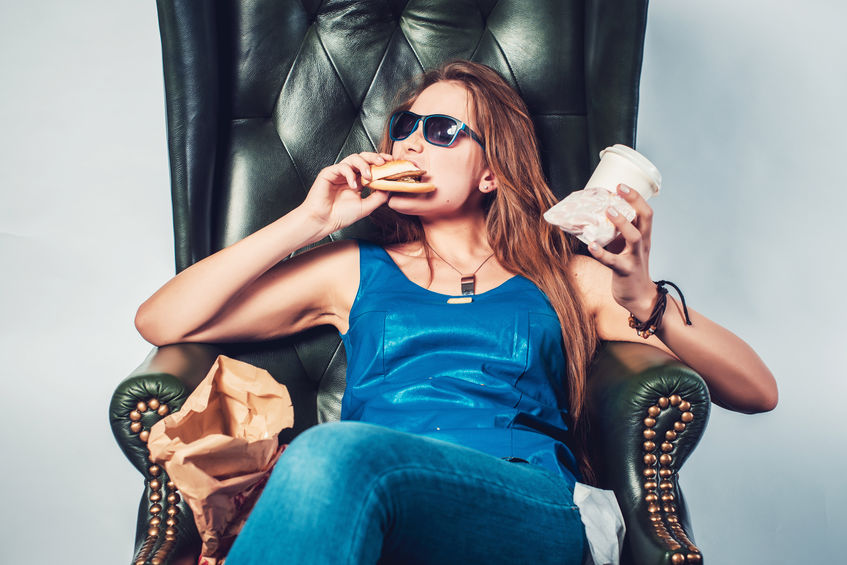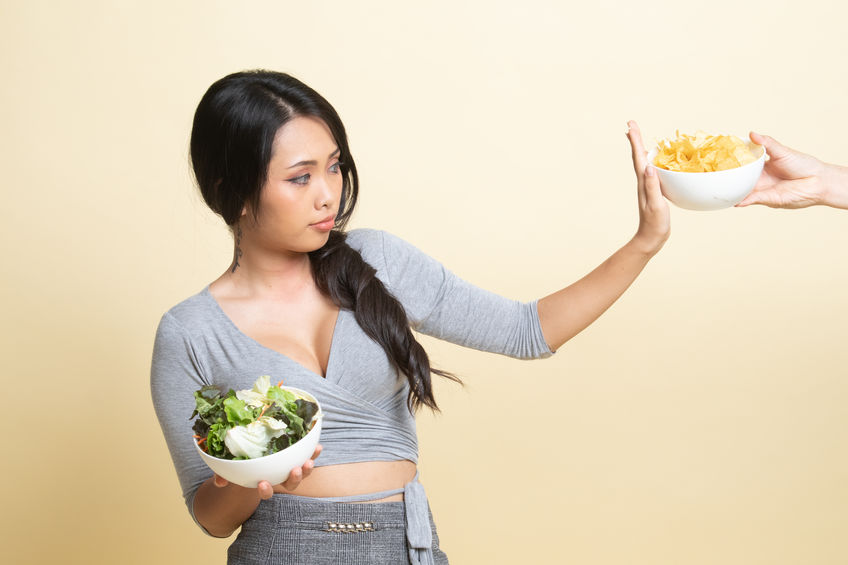
Your stomach isn’t growling, but still, all you can think about is the experience of donuts, a sundae, fried chicken, or chocolate for example.
When that feeling arises, it can be helpful to have some logic to help understand why this may be happening so you can override the desire to eat everything in sight.
In today’s post, I wanted to take a look at some of the reasons we get cravings, along with some possible solutions!
1. Emotional association
Remember eating apple pie at your grandmother’s house or the taste of ice cream after a game? Food has so many emotional associations. Many foods are connected with memories and feelings, and eating them has the power to trigger all of those good sensations.
Maybe you catch yourself standing in front of the fridge after having a fight with someone, ready to reach for something that will make you feel better.
Or maybe it’s a habit that you have developed – an association with an experience, like “I always eat dessert after dinner because that’s what I did growing up,” or “I always felt the most joy as a child when there was something sweet involved.”

Even when you’re not “hungry” you can still override those feelings of fullness because emotion, and the memories we have associated with our emotions, are often far more powerful than logic or reason and can trump your body’s biofeedback.
The difference between being hungry and having a craving is that when you’re hungry, you need food, and when you’re craving, you need a feeling.
The thing about that “good” feeling we get from eating when we’re not actually hungry is what I’d call the “band-aid” effect. It doesn’t actually solve the thing we’re really missing.
CRAVING HACKS FOR EMOTIONAL ASSOCIATIONS:
The next time you experience a craving, set a timer on your phone for 10 minutes. Simply wait the craving out and during the time, reflect either by journaling, talking to a friend, or simply thinking through why you want that specific food.
Give yourself a chance to notice any lack of feelings you’d like to be experiencing and consider if there are any other ways you could feel those feelings. When the timer goes off, the craving may have already passed. If it has not set another timer and challenge yourself to beat it. Repeat as needed!
Damage Control
If you ate something that’s making your head hurt, your stomach hurt, or you just feel over-sugared, you can practice damage control by:

2. Drinking water laced with freshly squeezed lemon.
3. Adding cinnamon to a beverage and drinking it.
All of those will help stabilize your blood sugar to decrease the insulin spike, but your body will still have to process the sugar.
It might be a good time to do some journaling – getting thoughts and ideas out of your head and onto paper (or into your phone) can help you look at them with a different perspective, which can often help you alter an unwanted behavior.
2. Judging foods as good or bad
Food is not “good” or “bad,” food is food. Some food is more nourishing than other food, and that’s ok. Of course it’s optimal to eat more nutrient-dense food for the sake of your health, but eating some foods that aren’t is part of life for most people, and often happens during enjoyable social gatherings.

That veiled self-judgement we get into can also trickle over onto other people. If we’ve decided a food choice is bad (and we are bad when we choose it) it means other people are being bad when they choose that food as well. Judging other people for their choices means we aren’t as open to learning from them, or accepting their views as valid.
So back to the cravings conversation – when we are judging the food (ourselves) as good or bad, it can create negative mental associations that we subtly rebel against. If something is “bad for us” we feel like our natural desire is being suppressed. Have you ever heard of a teenager who didn’t try to sneak out or break the rules when they were strictly told they had a curfew?
If we feel like we “can’t have something” we sometimes obsess about it MORE, and end up wanting it more than we would have if it were available to us. Setting us up to crave it. Then we break our own rules, which does more damage than just enjoying it because usually after we break the rules, we feel remorse, guilt, shame and stress – and tell ourselves we’ll never do it again, diet starts tomorrow, repeat, repeat, repeat.
CRAVING HACKS FOR JUDGING FOODS GOOD/BAD:
As an initial step to beat the “good foods/bad foods” frame in your mind, consider adopting a “no strings attached” (NSA) philosophy when it comes to the less nutritious foods. Rather than calling them “cheat meals” or “cheat foods” (because you’re not cheating on yourself or doing something to undermine yourself) simply see them for what they are – less nutritious foods. When you choose to do things on purpose, there’s no need to feel guilty.
If your body is a bank account and you need to deposit a certain amount of nutrients daily so you have plenty to draw from in energy, brain power, movement capacity, and muscle tissue for instance, then the meals you choose all add up to what you can draw down on. Those less nutritious meals don’t add to your balance. You don’t want to eat them at every meal, or you can end up depleted of reserves, but eating them on occasion isn’t going to “break the bank.”
Adopting an NSA mentality reframes the perception of these foods or meals so you can be present and in the moment and enjoy yourself, while still having a bigger picture awareness that you take care of yourself and want to keep a positive balance in that nutrient savings account.
3. Advertising exposure
This one is so obvious when you think about it, but it’s actually hidden in plain sight. As humans, we’re highly suggestible and easily influenced by appealing imagery and messaging. And there’s nothing wrong with that. Just something to be aware of when it comes to why we’re having cravings.
When we’re watching TV at night we get nice and comfortable on the couch, and maybe we have some snacks we want to enjoy. Because our primary focus is on what we’re watching and not the signals we’re getting from our body, it’s easy to mindlessly munch and end up overeating.

Even if you’ve made your own nourishing snacks, it can be hard to notice when you’re full. I don’t think we really need a lot of snacks, if we’re eating nutrient dense, satisfying meals, normally your body is fine until the next main meal. But we can’t always get fed at the optimal time, so having a healthy nutrient-dense “mini meal” with you can be a great way to keep your blood sugar from dropping.
However many of the pre-made snack foods we’re told are so convenient are NOT nutrient dense mini meals. They spike your blood sugar and don’t leave you feeling as full and satisfied as you would have with say, and apple and some nuts. We buy snacks because we’ve been convinced we can’t make it between meals without them. We buy many pre-made foods because they’ve been marketed to us as “convenient” and “time saving” or “a great deal.” Advertising messages are powerful drivers of our choices and they convince us to take actions we might not otherwise take.

Or how about when you browse different websites, looking for a recipe? I personally get frustrated when going to websites with dozens of pop-ups, and when I have to scroll a mile through a hundred ads just to get to the actual recipe. But the reason people do that is because it’s effective and it makes money. We are influenced by what we see, and this is just another form of advertising that can have an influence on your desire (or craving) for something you didn’t know about before.
Foods and products in shows that your favorite characters are eating or drinking drive powerful associations with the desirability of these products. Have you ever been watching a show and the characters are drinking wine, making you want to pour yourself a glass? Nothing wrong with watching the show, nothing wrong with wanting the wine, nothing wrong with having the wine. What’s questionable is being on autopilot and taking action because of the power of suggestion and not asking yourself if you’re really hungry/thirsty/want a glass of wine. And on potentially not stopping when you would have normally because you’re on autopilot.

This is also the hallmark of “influencer marketing” which is now a big part of how brands currently get products in front of consumers on social media. In a perfect scenario, an influencer would love and use the products they get paid to promote (and the product would do what it says it does, be well-researched, and of good value), and the influencer would have real, genuine experiences to share. I like to give people the benefit of the doubt, but I do my own research on anything someone I like is suggesting, and recommend you do too.
CRAVING HACKS FOR ADVERTISING EXPOSURE:
Be aware of the ads you’re seeing, especially the ads you see over and over. Marketing research shows that the more someone sees an ad, the more likely they are to be open to making a purchase.
Be aware of the “influence” people you follow have over you and do your own due diligence in researching the products they recommend.
Have veggies cut up and enjoy them while you’re watching a show if you want something to munch on.
Try Sugar Snap Peas
My #1 go-to snack at night – they’re sweet, they’re crunchy and I can eat a bunch of them and just feel awesome.
I always wash my sugar snaps and put them in bags in the fridge so I see them when I go foraging in there at night like a little bear.
Hearts of Romaine are another one I like too – eating plain greens has proved to be an excellent trick to keep cravings at bay and can help “turn off” the sweet craving.
Hot water with ginger and lemon – and sometimes some fresh mint- just make yourself something nourishing and warm as an act of self-love, which is what this entire post is about really, and what cravings often come down to. How can we give ourselves love?
Another good one is ginger, fenugreek seeds, and a cinnamon stick. Both are detox organ-supporting blends, immune boosters and sources of anti-inflammatory nutrients. I love it at night and it always makes me sleep better than eating a bag of chocolate or candy ever has!
4. Lack of Sleep
The sleep-wake cycle plays a major role in our ability to regulate appetite. The hormones that influence control over blood sugar and appetite control are deeply impacted by your sleep quality and quantity.

During sleep, glucose tolerance and insulin secretion (manages your blood sugar), leptin (the fullness hormone) and ghrelin (the hunger hormone) are organized and regulated.
Without proper sleep, these regulatory chemicals get disrupted and can’t follow their normal pathways that keep you connected to eating in accordance with your body’s energy needs, causing cravings and disrupting feelings of fullness after eating, causing you to reach for more.
CRAVING HACKS FOR LACK OF SLEEP:

Get off your screens and devices earlier in the evening, and consider wearing blue blocking glasses once the lights come on in your house. This will allow melatonin, your hormone that promotes tiredness to naturally rise and help you fall asleep and stay asleep.
Get in the habit of doing a journaling, breathing or meditative exercise before bed to help lower cortisol (the stress hormone) and promote a feeling of relaxation and calm that will help you both fall asleep and stay asleep.
Consider a natural sleep supplement like SereniCalm (one of my Whole Betty formulas) made of natural herbs and organic compounds that support you body’s sleep cycle and can give you a boost to fall asleep more easily, stay asleep and sleep more deeply, and wake up feeling more refreshed.
5. Getting dehydrated
Water is one of the most essential components in the human body, making up 75% of all muscle tissue, and 10% of fatty tissue. It also transports nutrients (like sugar) through cells, and filters wastes.
Dehydration is one of the most common causes of sugar cravings. When you’re hydrated your body can easily access its glycogen (stored sugar) reserves, helping to keep your energy stable. But being low on fluids makes it harder for the body to access and metabolize those resources – meaning we start craving sugar to give us some quick energy.

Many of us are dehydrated and we don’t even know it. Water is necessary to the function of all our internal organs, and dehydration is also a common causes of digestive problems, lymph congestion (your immune system pathway), and can inhibit your body’s natural detoxification pathways.
If you exercise regularly, it is essential that you stay hydrated. Dehydration not only causes muscle fatigue and cramping, the body’s ability to thermoregulate (maintain body temperature) is decreased. It’s easy to become dehydrated if you do a lot of cardio and are sweating a lot without replenishing yourself, and if you’re consuming alcohol regularly or drinking more than a cup of coffee daily.
Don’t get caught with unnecessary cravings just because you forgot your water bottle.
CRAVING HACKS FOR DEHYDRATION:
When you are feeling cravings, check in with yourself: have you had enough water? Have a glass and wait 5 minutes and see if you still have the craving.
Always bring your water bottle when you leave your house.
Start your day with 1-2 glasses of water, and drink water throughout the day.
Drink more water when you’ve been sweating.
6. Not eating enough dietary protein
I’ve found that many of my readers tend to downplay the importance of protein when planning meals. However, once they start intentionally incorporating this vital nutrient, it’s much easier to feel full and satisfied after a nourishing meal.
Protein is more satiating (satisfying) in the long run than fat or carbs. Over time, protein can simultaneously reduce your hunger hormone (ghrelin) levels and boost your levels of a satiety hormone (peptide YY), so if you’re skimping on it, you’re missing out on that full, satisfied feeling your body enjoys while the digestive system does its thing.
Protein is needed for everything from hormone regulation, enzyme production, and the regulation of our body fat.
Eating protein leads to a release of glucagon, a hormone that helps encourage fat out of your fat cells so it can be used up by your muscles. And it helps your fat cells become less receptive to storing fat.
So if you’re not mindfully including protein with each of your main meals throughout the day, your cravings could be related to not feeling full and satisfied by the intake of this important nutrient.
CRAVING HACKS FOR NOT EATING ENOUGH PROTEIN:
Include protein with each main meal, and on training days consider adding in a protein shake to boost your total intake to support muscle protein synthesis.
Start looking up the amounts of dietary protein in different foods you’re eating to make sure you’re getting a minimum of 20 grams of protein per meal.
If you exercise regularly, you may need more protein per meal as supporting muscle protein synthesis goes beyond the “minimum daily requirements, which are a low baseline for sedentary people.
If you’re over 40 you may need more protein, as we do not absorb dietary protein as readily as we age. Listen to the podcast with Dr. Gabrielle Lyon who discusses sarcopenia and the needs of older adults for protein.
Consider using a whole-food based protein supplement (powder) to boost your total daily intake of protein.
7. Eating foods that raise your blood sugar (too frequently)
Sugar is more addicting than almost any other substance because it literally causes a chemical reaction in your brain. Your body might be seeking the next energy spike if you’ve been eating foods with too much sugar, and that’s where your craving is coming from.
Eating a lot of sweet or salty foods on a regular basis (which can happen with processed and packaged foods, restaurant and fast-foods, etc.) puts your body in a constant yo-yo of trying to balance your blood sugar, your energy, and your hormones.

You have to really watch out for a lot of pre-made, packaged foods. Read those food labels. It’s easy to be eating what we think are “health foods” or “convenient snacks” or “shortcuts” that have sugars added to them that cause this constant erosion of our intentions to actually consume less sugar.
Over the course of the day, between regular whole foods and those types of foods, you’ll be way over your sugar intake needs and your body will happily package up the extra to store as fat for you.

Your body can store the glucose you don’t need for immediate energy in 3 places, your liver glycogen, your muscle glycogen, and/or your fat cells.
“Nutrient partitioning” describes which of these 3 paths will be taken, and that has a lot to do with your current amount of body fat, muscle mass, and hormone levels – particularly insulin.
If you are insulin resistant, fat storage is prioritized. If you have good insulin sensitivity, muscle and liver storage is prioritized. Improving insulin sensitivity can help you reduce insulin resistance, and reduce the risk of many diseases, and ensures your body converts the energy from your food in the most efficient manner (including supporting your muscle).

The more insulin sensitive you are, the more readily your nutrients will be partitioned to the muscle tissue to be stored as glycogen (rather than fat storage).
Improve your insulin sensitivity by eating whole foods, and getting regular exercise.
Constantly eating high sugar foods (or eating in excess of what your body can process) triggers the insulin response over and over, leading to insulin resistance. Doing the opposite of that, eating low-glycemic (low sugar) foods – in the form of fiber rich whole food carbohydrates is a great way to improve your insulin sensitivity.
A slower, steadier influx of glucose (rather than a huge spike) gives insulin a chance to do its job at the right pace. Including fiber helps us feel more full – meaning we won’t be as likely to overeat.
Dietary fat has a similar effect, slowing down nutrient absorption and making us feel more full and satisfied so we’re not as likely to overeat. Plus, fat is very nutrient dense, giving us plenty of energy in a smaller package.
CRAVING HACKS FOR EATING FOODS THAT RAISE YOUR BLOOD SUGAR TOO QUICKLY
Cooking your own foods so you know exactly what’s going into your body is an ideal way to support your muscle tissue and keep cravings at bay.
Eat WHOLE FOOD CARBOHYDRATES that come complete with their natural fiber, helping to slow the release of their natural sugar into your bloodstream.
Eat plenty of GREENS, which contain fiber and micronutrients that your body needs for cell function and optimal metabolism, and one of my go-to favorites when cravings hit – I will literally eat a handful or two right out of the refrigerator to give my body an instant boost of goodness as I figure out what my craving might be telling me.
Eat Enough HEALTHY FAT which is very satiating, especially when paired with foods that don’t irritate your digestive system. This means you feel fuller faster, which means you are less likely to overeat. The consumption of fat before or with any meal slows the rate at which food exits your stomach. This stabilizes blood sugar levels, preventing harmful insulin spikes that trigger fat storage and lead to weight gain.
EAT PROTEIN WITH EACH MAIN MEAL as I mentioned above, as protein is even more satisfying than fat or carbs, and can help prevent overeating and cravings later on – in addition to all of its other important jobs in your body.
Set yourself up for success and beat cravings with a plan for what you’re going to eat in advance.
The Body Fuel System uses my simple, proven Eating Types to make it easy to stay on track. It also gives you healthy, fat-burning recipes and foods you can eat to look and feel your BEST every day!
Recipes like….
This is my signature eating system and it contains 6 weeks of done-for-you meal planning and recipe guides! You will not only learn the strategies that have given me long-term success, but also enjoy the time-saving benefits of having it all planned out for you!
Learn more right here, and find out why people love this program so much!
- Alberts HJ, Mulkens S, Smeets M, Thewissen R. “Coping with food cravings. Investigating the potential of a mindfulness-based intervention.” Science Direct. 2010. Web. https://www.sciencedirect.com/science/article/pii/S019566631000365X?via%3Dihub
- Avena, N. M., Long, K. A., and Hoebel, B. G. “Sugar-dependent rats show enhanced responding for sugar after abstinence: evidence of a sugar deprivation effect.” Science Direct. 2005. Web. https://www.sciencedirect.com/science/article/abs/pii/S0031938405000065
- Morewedge, C. K., Eun Huh, Y., and Vosgerau, J. “Thought for food: imagined consumption reduces actual consumption. Science. 2010. Web. http://science.sciencemag.org/content/330/6010/1530.long
https://www.ncbi.nlm.nih.gov/pmc/articles/PMC3065172/
https://pubmed.ncbi.nlm.nih.gov/17212793/
https://www.ncbi.nlm.nih.gov/pmc/articles/PMC4358156/




